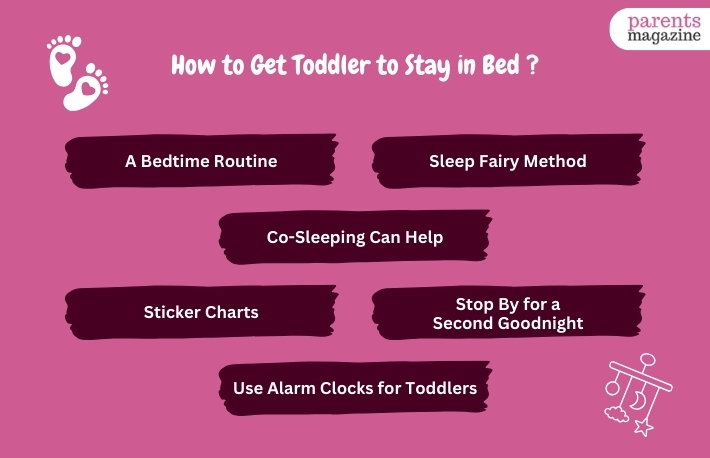
How to Get Toddlers to Stay in Bed? Effective Tips for Sever Night Waking
How to get toddler to stay in bed?
Here’s a problem many parents with preschoolers and toddlers are going through.
You hear them crying out in the middle of the night or crawling in your bed since they can’t sleep.
Usually, this happens because of severe night waking. Sometimes, it can be because of a new skill your child is developing.
If you are a parent dealing with these midnight sleep hurdles, here’s help.
Sleep Concerns in Toddlers

Does your toddler keep getting up at night? If yes, why?
When you find it hard to keep your toddler in bed at night, it might be because of sleep or settling concerns.
Does Your Toddler Have Any Sleep Concerns?
When they wake up at night without disrupting your sleep routine or that of the family, there’s no sleep concern to worry about.
But if the child is experiencing severe night waking, it is time to take it seriously. But what is severe night waking anyway?
Your child will do the following things when they are experiencing severe night waking more than five times a week –
- Consistently waking up three or more times a week.
- It took over 30 minutes to settle down and sleep again.
- The child stays awake for more than 20 minutes after waking up.
- Having difficulty sleeping and causing distress to the caregivers or the parents.
How to Get Toddlers to Stay in Bed?

If your toddler wakes up at night, then they might be facing severe sleep concerns. Do take advice from pediatricians or healthcare providers
Here are some effective ways parents can keep their toddlers in bed during sleep hours –
A Bedtime Routine
When the toddler is going through sleep concerns, it’ll be difficult to put them to sleep or keep them in bed. You can start by setting a proper bedtime and maintaining regularity in your baby’s sleep routine. Here are a few tips for further help –
Following a bedtime routine is the best way to keep your toddler in bed. It’s also crucial to follow that bedtime. Children who have a consistent bedtime fall asleep easier than others. Plus, a bedtime routine takes away the signs of exhaustion.
It works best to ready your child for sleep and spend an hour relaxing before they finally fall asleep.
Most parents usually try singing lullabies or playing quiet music, helping the children fall asleep.
Children who are fond of stories also respond well to reading books.
A warm bath or shower can also relax your child and prepare them for sleep.
It’s important to have quiet time before your child falls asleep. Try to build a habit where your child disconnects from electronics (TV/ smartphones) before falling asleep. Lights from the screen trick your child’s brain into thinking it’s daytime. So, they’ll have more difficulty falling asleep.
Sleep Fairy Method

Bedtime routines can often seem forceful. Toddlers don’t always respond to forceful routines. So, make sleeping interesting for your toddler.
Want to know how to get your toddler to stay in bed?
Try the Sleep Fairy Method
It’s a process to help your toddler sleep. The process takes the parent out of the picture and lets a fairy intervene. Tell your 2 to 4-year-old toddler that if they sleep well, the fairy will have a reward for them in the morning. There are three steps to following this method –
The Fairy is Real
Tell your child about the sleep fairy. If they fall asleep, the fairy will visit them and give them beautiful dreams. In fact, you can tell them that the fairy leaves a reward for children who fall asleep fast.
Build Expectation
The younger children will get gifts more frequently than the older ones. Setting up expectations helps your child put effort into their sleep routine.
Follow Through
Now, a reward doesn’t always have to be a toy or a favorite cookie. Try following through with appreciation, at least. Tell her how good they look after a good night’s sleep. A reward can also be a walk in the park or playing arcade games together.
Toddlers old enough to understand the story of the Tooth fairy would often respond to the sleep fairy idea.
Co-Sleeping Can Help

To initiate a good sleep, you need to follow these steps:
- Start by soothing your child to sleep.
- When your child goes to bed, comfort them and be with them.
- Gently pat their head and have them calm down so that your child can fall asleep easily.
No, it’s not necessarily a recipe for good sleep, but co-sleeping does have some positive effects on your child. It is believed across cultures and science that co-sleeping helps children sleep better.
When parents share the bed with their children, it makes them feel more secure and helps them fall asleep at ease.
While sleeping with the children in the same room, parents help synchronize the children’s circadian rhythm. It helps consolidate your child’s sleep. In fact, co-sleeping helps parents raise emotionally strong children and helps add to their overall growth and well-being.
Parents wondering how to get their toddlers to stay in bed can try soothing their children to sleep and practice co-sleeping.
Sticker Charts
Sometimes, your child might be too clever for ideas like Tooth Fairy. Sometimes, sticker charts can take that sleeping game to the next level.
It’s a simple reward system. If your child sleeps throughout the night without waking up, they get a sticker in the morning. There will be different stickers assigned to different types of sleep patterns.
You can assign different rewards to different stickers. Each of the stickers can lead to a special reward for the toddler.
If your toddler is strong-willed, this reward or incentive-based program can work well for them. This process should help them understand and learn the benefits of doing the right thing.
Stop By for a Second Goodnight
All your child needs to fall asleep is a sense of security and relaxation. Once they are relaxed, they can quickly fall asleep. Some are often too clingy to their caregivers and would request them to stay until they are asleep.
A little promise can help your child fall asleep and stay in bed. Just promise to return after saying goodnight and try to hold on to that promise.
Try coming back after a few minutes and checking up on your child. Usually, they should fall asleep. But, sometimes, your child stays awake even after the first good night. A second goodnight visit can help your toddler stay in bed and fall asleep.
Once this process starts to be effective, try increasing the gap between your second visit. You can leave them quietly as they start to feel drowsy and half asleep for the sleep and goodnight message.
Use Alarm Clocks for Toddlers

How to get your toddler to stay in bed at night? A wake-up clock can help your older adults. Especially when your toddler is waking up repeatedly late at night, a wake-up clock can help. An alarm clock can queue your child and remind them when it’s the right time to wake up.
Some kids need help realizing the concept of time. If they are constantly waking up at 3:00 clock, then it’s time to fall asleep again. Some clocks use colors to signal your child when they should wake up.
You can give them instructions like, “if the clock turns green, then you should wake up.” Until then, I suggest they lay down in bed.
However, this concept works better for kids who don’t understand the concept of time. Plus, kids who love working on rules and structures would respond better to wake-up clocks.
Final Words
The best way to deal with this long-term is by understanding what works for your toddler. Some would better respond to sticker charts, while some would need to co-sleep with their parents. Once you find the solution, continue using it for a week or two.
But this shouldn’t be the final solution to lull your child to sleep. They should inherently stay in bed during their sleep hours. So, parents must let go of such tricks gradually.
Suggested:
Already have an account?
Sign In
Create your account
User added successfully. Log in








